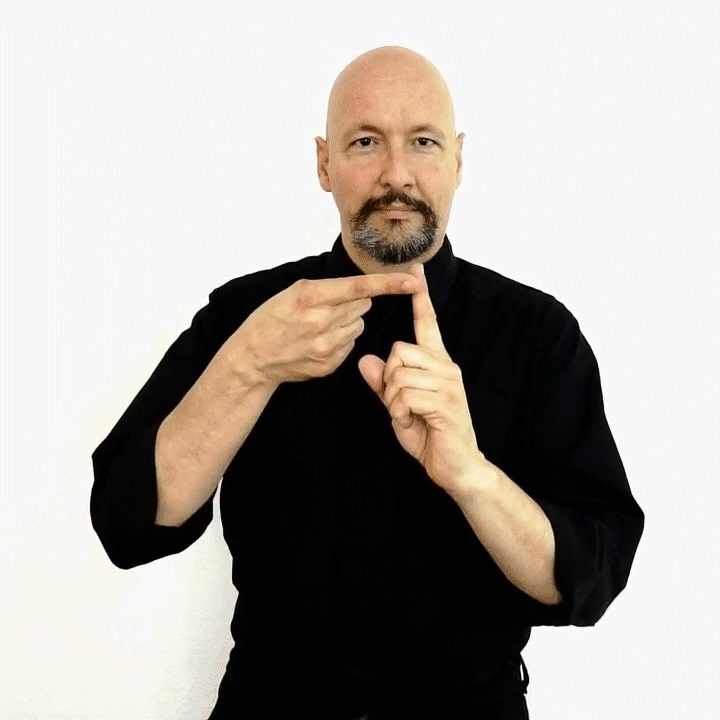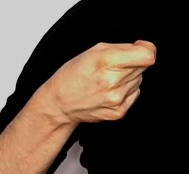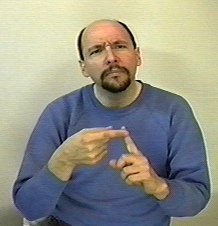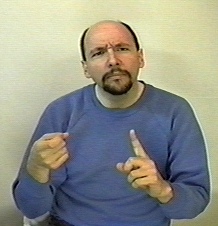American Sign Language: "from"
The sign for "from" starts with the dominant hand in a "1" handshape (as an index finger), and then changes into an "x." The base hand: Starts and STAYS as an index finger. Pull the dominant hand back away from the non-dominant hand as if pulling back a string on a bow.
FROM:
Note: The "X" handshape!
FROM YOU? (Where are you from?)
Here is another version:
YOU FROM WHERE? (Where are you from?)
Notes:
Quite often the sign "WHERE" is dropped during this question. We simply use a furrowed brow combined with the signs "FROM YOU" to equal "Where are you from?"
Here we see "FROM" as part of the phrase "Where are you from? (Note the lowered eyebrows.)
OPTIONAL DISCUSSION / no need to read beyond this...
Dear Dr. Bill,
while using furrowed eyebrows! The "where" concept is expressed by the furrowed eyebrows and thus doesn't need a separate sign. I like to write that as: "YOU where-FROM?" I lowercase the word "where" in the gloss as my way of indicating that it is "included" in the concept but doesn't use a separate sign. Also, we tend to drop the sign YOU from that question if it is obvious to whom we are asking the question. If we are meeting three new people we might tend to add "YOU" or "YOU-plural/sweep" to the sentence to clarify exactly to whom we are asking the question.
I am presently taking an ASL class (this time at a Community College with Gallaudet professors, reason why going there, for them as teachers!) and am having some problems with the WAY they are teaching this course. I've taken private lessons from a Gallaudet alumni who teaches in small groups, is a storyteller, signs BEAUTIFULLY (OMG!), and in 2002 was taking this SAME EXACT course (at the same college, but with a VERY different book - and teacher)...anyway...in one of your lessons you state that it is okay to sign, "WHERE FROM YOU?"
I have always been taught that in ASL the English question:" Where are you from?" would be translated into ASL as:
"You from where you?" as opposed to "Where from you?"
I can deal with the new signs and different meanings for the same sign, but I'm getting so confused due to learning from so many different people, all whom seem to have different ideas of how to TEACH sign, all are Native ASL users, and they are also using different ways of forming "sentence" structure, which is the MOST confusing to me.
-- Name on file
Dear Student,
In general in ASL we do tend to put "wh" type signs (who, what, when, where, why, & how) at the end of question sentences.
To understand why we do this it helps to realize that it feels strange and/or uncomfortable to hold a WH facial expression (furrowed eyebrows) for the duration of a medium length or longer sentence (four signs or more).
So we tend to move the WH question to the end.
The facial expressions we use in ASL to form questions are the equivalent of how Hearing people raise the tone of their voice.
Here is the thing to understand though, when Hearing people ask very short questions, they raise the tone of their voice throughout the whole question.
Hearing people do this because the meaning of this very short utterance is actually made more clear by using the raised tone of voice throughout the whole sentence (since the duration is so short). Try it yourself. Say "Are you GOING?" and only emphasize the last word. Then voice it again and emphasize all three words: "ARE YOU GOING?"
You will probably think that it feels "weird" to try to say "Are you" (normal voice) and then switch over to "GOING?" (high tone) for just the last word. It feels "better" to just say all three words in high tone since the sentence is so short. It is more smooth and less jarring to use one tone for a short sentence than to try to cram two different tones into a three word question. Just as common (for Hearing people) is to say "You going?" -- with a rise in the voice taking place of the "are." Which is to say, Hearing people often do not "say" the word "are" but rather indicate "are" by raising the voice.
The same thing applies to signed conversations using short three-concept questions. Very short questions can use the WH question at the beginning of the sentence since it becomes more smooth and "economical" to form one facial expression for a three-sign sentence using a non-topicalized sentence structure than it is to form two different facial expressions for a 3-sign sentence using a topicalized sentence structure.
Many ASL teachers (even the really "good ones" that teach at prestigious universities) and who sign "really well" have pre-conceived notions and/or biases that prevent them from wrapping their minds around this principle.
Now, how do advanced signers really ask where someone is from? We don't even use the sign "WHERE." HA! We just sign "YOU FROM?"
Cordially,
Dr. Bill
Question:
In a message dated 3/31/2003 1:18:58 AM Central Standard Time, Scott writes:
I met a fellow church member who interprets for another church nearby when he isn't attending services at my church. We just had a few brief minutes to converse before he had to return to ushering duties. He's the first person that can sign that I've really approached. He was very pleasant and encouraging, but he immediately corrected me on some of my signs. His sign for the word "from" was different than the one demonstrated in all of my sources. Instead of holding the left index finger up and pulling at the tip with the right index finger, he instead pointed the left index finger pointing to the right, and lightly touched it with the right index finger and pulled it away. It threw me until he explained it as the word "from". Have you seen this used in Texas? (BTW, I lived in Abilene for 10 years. Directed the Hardin-Simmons Cowboy Band while there.)
Thanks for any insight you can provide.
Cheers!
Scott
Dear Scott,
Regarding the sign "FROM." This is one of those signs where books and ASL teachers tend to show one thing and real language users do something else. See the forward slash on your keyboard that looks like this: /
Your left (or non-dominant) forearm and index finger are at about that angle. Neither vertical or horizontal but somewhere in between. Again note that it is much more physically comfortable to have it at an angle. I'd have it more up than sideways though. But the more relaxed, casual, and faster you do the sign "FROM" the more the non-dominant hand tends to become horizontal.
-- Dr. Bill
Want to help support
ASL University? It's easy:
DONATE (Thanks!)
(You don't need a PayPal account. Just look for the credit card
logos and click continue.)
Another way to help is to buy something from the ASLU "Bookstore."
Want even more ASL resources? Visit the "ASL Training Center!" (Subscription
Extension of ASLU)
CHECK IT OUT >
Bandwidth slow? Check out "ASLUniversity.com" (a
free mirror of
Lifeprint.com less traffic, fast access)
VISIT >
You can learn
sign language
(ASL) online at American Sign Language University ™
Lifeprint.com © Dr. William Vicars





